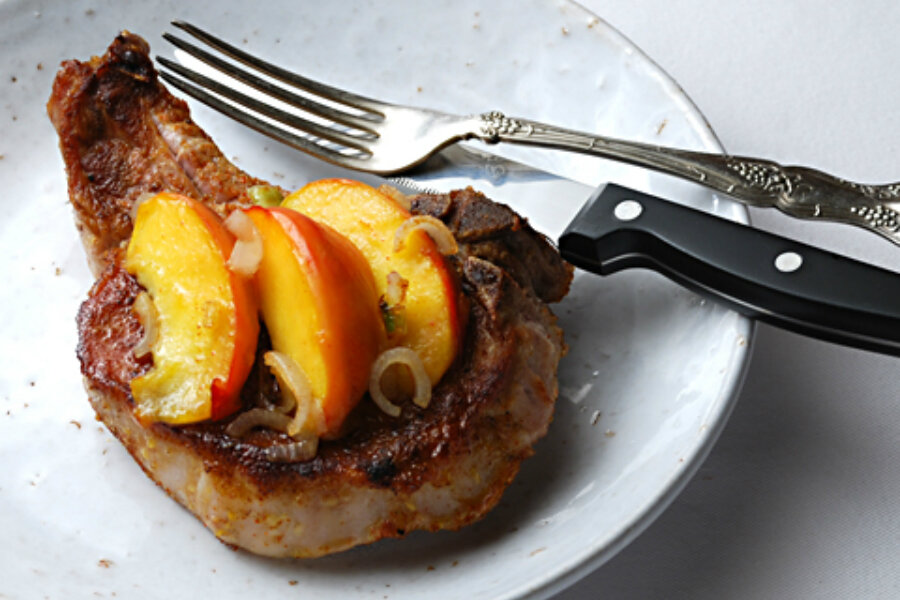Spicy pork chops with balsamic peaches
Loading...
Summer isn't summer without stellar peaches. Fragrant, sweet, delicious, juice-dribbling-down-your-chin peaches.
So when Hannah mentioned balsamic peach pickles in her comment on wedding food memories post, we were immediately looking for recipes. Not so much for making pickles from peaches (they do sound wonderful, thought, don’t they?), but for tempering the natural sweetness of peaches with balsamic vinegar’s tartness. And when Marion turned up a pork recipe, my search narrowed considerably.
There’s something about the natural savory/sweetness of pork that plays beautifully with fruit. And I’ve certainly exploited it here, making everything from roast pork tenderloin with cherries or with pears and onions to pork chops with dried plums and even bacon marmalade sandwiches on pumpernickel.
These quick and easy pork chops not only make use of pork’s affinity for sweet flavors – they also take advantage of how well it works with big-flavored spices. In this case, chili powder, cumin, and cayenne pepper. The first two pack a little heat, but mostly just punch up the taste – and by adjusting the amount of cayenne pepper, you can regulate the heat to your liking.
Pork Chops with Balsamic Peaches
Serves 4
For the pork chops:
1/2 tablespoon good quality chili powder
1/2 tablespoon ground cumin
1/2 teaspoon salt
freshly ground black pepper (I didn’t measure this – use a generous hand)
4 bone-in pork chops, about 1/2 pound each
2 tablespoons canola oil
For the peaches:
2 firm ripe peaches, sliced (see Kitchen Notes)
1 tablespoon balsamic vinegar, preferably white (see Kitchen Notes)
a drizzle of olive oil, plus more for the pan
1/4 teaspoon cayenne pepper (or to taste)
1/2 cup sliced shallots (you can substitute onion, but shallots are better)
1. Prep the pork chops. Combine the chili powder, cumin, salt and black pepper in a small bowl. Pat chops dry with a paper towel and season on both sides with spice mix, rubbing it into the chops. Set chops aside.
2. Prep the peaches. Place peach slices in a shallow bowl. If peaches are on the firm side of ripe, taste a slice. If it’s puckery tart, sprinkle on a little sugar, stir gently and taste again. You don’t want to make the peaches overly sweet, but just aim for balancing the tartness. Drizzle peaches with balsamic vinegar and olive oil and stir gently to coat. Sprinkle on cayenne pepper and stir again. Set aside.
3. Heat a large nonstick skillet over a medium-high flame. Add canola oil, then add chops. Sear on one side for 5 minutes, then turn. Reduce heat to medium and cook until chops are just cooked through 4 to 5 minutes, depending on thickness. I covered the pan after turning the chops to retain a little more moisture. Transfer chops to a plate and tent with foil.
4. Heat a medium nonstick skillet over a medium flame. Add a tablespoon or so of olive oil and sauté shallots for a few minutes until they’re just getting tender and translucent. Add peach slices to pan and cook for just a minute or two until they’re heated through, turning them carefully. Transfer peaches and shallots to a bowl to stop the cooking process. Plate chops and top with peaches/shallot mixture. Serve.
Kitchen Notes
Peaches – skins or no skins? Many recipes for various treatments of balsamic peaches called for peeling the peaches. I prefer them with the skins on here. First, it adds another touch of color to the plate. More practically speaking, it makes the slices more durable during the cooking/stirring process – you don’t want to end up with peach mush. Oh. And the recipe produces more peach slices per pork chop than the three artfully arranged ones you see in the photo above. You can either arrange a few as I have here and serve the rest next to the chops, or you can pass the extras at the table.
Ripening peaches. If your peaches are less than ripe, place them in a brown paper bag and fold the top closed. Check them daily – in a day or two, they should be ripe. Why does this work? Glad you asked. When fruits begin to ripen, they release ethylene gas, which causes the cell changes in fruit we associate with ripening. According to Chow.com, placing fruit in a loosely closed paper bag “traps the ethylene gas inside and accelerates ripening. Don’t seal the bag too tightly or use a plastic bag, however – if you trap too much moisture, mold may grow. If you really want to ripen things in a hurry, put an apple in the bag with your other fruit – they produce a lot of ethylene gas.”
Use white balsamic vinegar if you can find it. This is a purely visual choice. Regular balsamic vinegar will color the peach slices. That’s not as big a deal if you’re chopping the peaches as some recipes call for to spoon over the chops as more of a salsa. And if you can’t find white balsamic, don’t let that dissuade you from making this dish. I found mine at Trader Joe’s.
Variations on a theme. First, if you just don’t do pork, these peaches would be quite good with chicken too, preferably grilled. And if you don’t do spicy, try grilled chops seasoned with just salt and pepper, and instead of cayenne pepper, add some fresh chopped sage to the peaches at the very end of their cooking.
And finally, if you’re looking for yet another way to take advantage of great peaches this summer, try this arugula salad with peaches and goat cheese.
Related post on Blue Kitchen: Roast pork tenderloin with cherries








